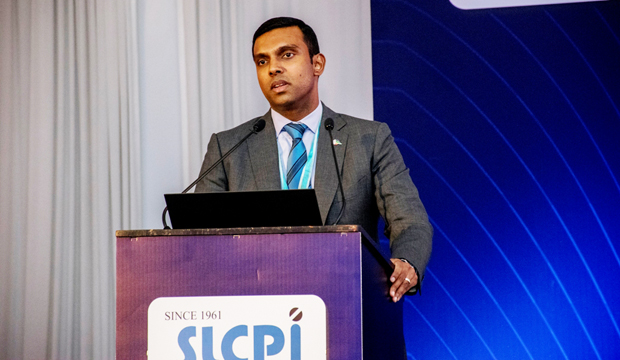December, 12, 2017

Given the rising global prevalence of cardiovascular diseases - which is responsible for one-third of deaths worldwide and a staggering 40% of deaths in Sri Lanka – The Sri Lanka Chamber of the Pharmaceutical Industries (SLCPI) called for urgent proactive stakeholder engagement to increase awareness on preventative care for CVD.
A broad disease category that encompasses coronary heart disease (CHD), stroke and peripheral vascular disease, current World Health Organization (WHO) estimates project CVS prevalence and mortality rates to double to 80% by 2020, with developing nations – particularly in the South Asian region - having to face the brunt of this rising epidemic.
In that context, SLCPI Chairman Shyam Sathasivam called for urgent proactive measures to be implemented with a view to increasing awareness of CVD risk factors and treatment, together with a concerted, systematic approach to combatting the disease.
“The breadth of underlying factors that contribute to CVD points to the need for decisive, long-term, multi-sectoral initiatives to combat this rising epidemic. A cornerstone of such a strategy must necessarily include the promotion of healthy diet and lifestyle choices. As a nation, we must work to help our citizens to understand the clear relationship CVD and an unhealthy diet, tobacco use and a sedentary lifestyle.
Similarly, we must place an equal emphasis on active collaboration and partnership between the public and private sectors in order to refine our healthcare delivery mechanisms in a manner that ultimately provides improved outcomes for patients, and prevents the spread of this deadly non-communicable disease.”
According to Sathasivam, the investment of capital, time and resources towards such proactive measures would be clearly felt in the economic performance of the nation given the complex interrelationship between economic development and the cost of disease on the productive capacity of a workforce, and the economy at large.
CVD can affect the entire economy of a developing nation. Disability, early mortality, and direct health expenditures can divert resources from savings, investment, and other productive uses, affecting economic well-being at the household level and growth potential at the national level.
Such challenges are keenly felt, even in developed economies with the American economy projected to have 100% of its Federal Budget having to be allocated towards healthcare by the year 2040, if rates of disease continue to increase at their current rates.
“Factors which contribute to CVD can be categorized into different sectors; behavioral factors (diet and physical activity), biological factors (blood pressure, cholesterol, BMI), health systems’ factors (access to better screening, diagnosis, and quality of medication), psychosocial factors (depression, anxiety, acute and chronic and lack of social support) and inter-sectoral factors (tobacco control policies). These factors provide the basis for a strong strategy to be implemented and coordinated across different sector, which integrates health promotion, prevention, and disease management as part of a long-term, comprehensive approach. Such approach would be ideal to promote the concept ‘cardiovascular health’ among Sri Lankans by employing a number of intervention policies that would accommodate distinctions according to context and background,” Sathasivam explained.
In that regard, he reiterated that in addition to efforts to popularize cardiovascular health in the country, the most important factor in fighting CVDs is to take a proactive stance against them. Relevant policies and programs to change the factors that contribute to CVD would be designed to work through population-wide approaches, through interventions within health systems and through community-based programs with components in schools, worksites, and other community settings, in a proactive manner.
“For individuals already at high risk or with existing disease, a proper proactive approach would combine education, support, and incentives to both address behavioral risk factors and improve adherence to clinical interventions. Participation in this approach extends beyond clinical providers and public health approaches including public media outlets, community leaders, and related sectors, especially food and agriculture policy, transportation and urban planning, and private-sector entities such as the pharmaceutical industry. All these players are potential partners both in assessing needs and capacity and in developing and implementing solutions.”
“Developing countries like ours will want to focus efforts on goals that promise to be economically feasible and have the highest possibility of intervention success. Priorities are different from a country to country but we can achieve significant progress in reducing cardiovascular diseases in a short term by implementing a set of prioritized tasks such as reduction of salt in the food supply and in consumption and improved delivery of clinical prevention using pharmaceutical involvements in high-risk patients,” Sathasivam explained.
Another key step in addressing CVD is to strengthen health systems to deliver high-quality, responsive care for the prevention and management of CVD. Improving health care delivery includes provider-level strategies, financing, integration of care, workforce development, and access to essential medical products.
“The local pharmaceutical industry understands the importance of providing our people with quality medication and state-of-the-art facilities to better screen and treat cardiovascular diseases to ensure a far healthier population and the SLCPI is fully committed to working with the Ministry of Health to reach this achievable goal,” stated Shyam Sathasivam further.
He further observed that the devising of a viable pricing mechanism for imported medicines could greatly assist the healthcare industry combating the detrimental effects of CVDs, by making top-quality medication available in Sri Lanka as well, and uplifting its risk mitigation capabilities.
While improving the quality of health services is vital to reduce the impact of cardiovascular diseases on Sri Lanka’s development, individuals too need to focus on improved lifestyles. Regular medical checkups and proper medication are necessary to ensure early detection and prevention, coupled with more active routines and improved diet.
In that regard, Sathasivam reiterated the SLCPI’s firm belief that in the battle against these diseases, a stronger health system supported by increased funding, more stringent regulations and increased collaboration of the Ministry of Health and associated medical bodies will be an absolute necessity.
Photo caption: SLCPI Chairman Shyam Sathasivam
Video Story